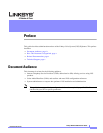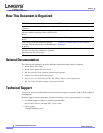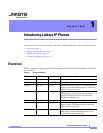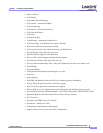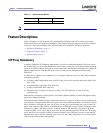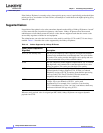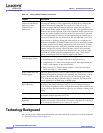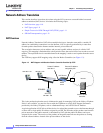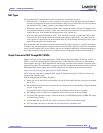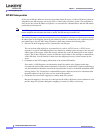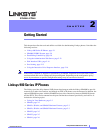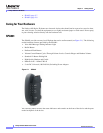
1-7
Linksys IP Phone Administrator Guide
Firmware Version 5.1
Chapter 1 Introducing Linksys IP Phones
Feature Descriptions
Other Features
Table 1-4 summarizes the features provided by Linksys IP Phones.
Table 1-4 Linksys Phone Features
Feature Description
Music On Hold On a connected call, Linksys IP phones may place the remote party on call.
If the remote party indicates that they can still receive audio while the call is
holding, the MOH server sends streaming audio.
Secure Calls A user (if enabled by service provider or administrator) has the option to
make an outbound call secure in the sense that the audio packets in both
directions are encrypted.
Adjustable Audio
Frames Per Packet
This feature allows you to set the number of audio frames contained in one
RTP packet. Packets can be adjusted to contain from 1–10 audio frames.
Increasing the number of packets decreases the bandwidth utilized, but it
also increases delay and may affect voice quality.
DTMF In-Band and Out-of-Band (RFC 2833) (SIP INFO) Linksys IP phones may
relay DTMF digits as out-of-band events to preserve the fidelity of the digits.
This can enhance the reliability of DTMF transmission required by many
IVR applications such as dial-up banking and airline information.
Call Progress Tone
Generation
Linksys IP phones have configurable call progress tones. Parameters for
each type of tone may include number of frequency components, frequency
and amplitude of each component, and cadence information.
Call Progress Tone Pass
Through
This feature allows you to hear the call progress tones (such as ringing) that
are generated from the far-end network.
Jitter Buffer—Dynamic
(Adaptive)
Linksys IP phones can buffer incoming voice packets to minimize
out-of-order packet arrival. This process is known as jitter buffering. The
jitter buffer size proactively adjusts or adapts in size, depending on changing
network conditions.
Linksys IP phones have a Network Jitter Level control setting for each line
of service. The jitter level decides how aggressively Linksys IP phones try
to shrink the jitter buffer over time to achieve a lower overall delay. If the
jitter level is higher, it shrinks more gradually. If jitter level is lower, it
shrinks more quickly.



